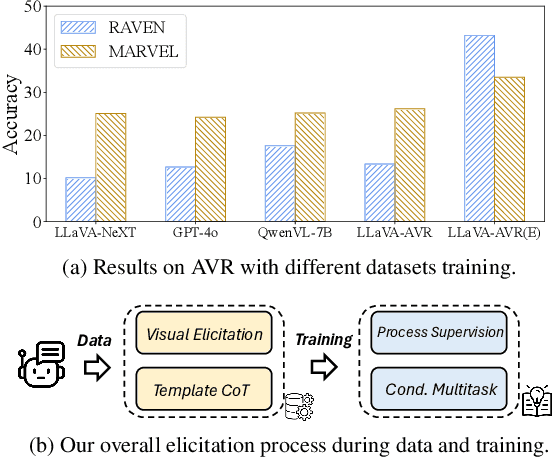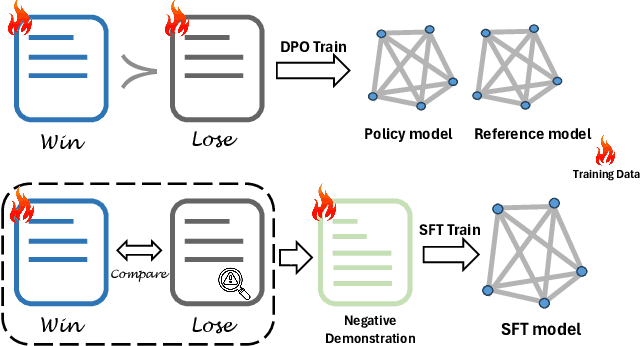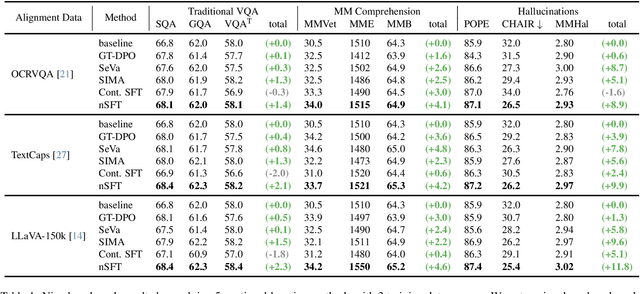Gang Zhang
Michael Pokorny
MMAT-1M: A Large Reasoning Dataset for Multimodal Agent Tuning
Jul 29, 2025Abstract:Large Language Models (LLMs), enhanced through agent tuning, have demonstrated remarkable capabilities in Chain-of-Thought (CoT) and tool utilization, significantly surpassing the performance of standalone models. However, the multimodal domain still lacks a large-scale, high-quality agent tuning dataset to unlock the full potential of multimodal large language models. To bridge this gap, we introduce MMAT-1M, the first million-scale multimodal agent tuning dataset designed to support CoT, reflection, and dynamic tool usage. Our dataset is constructed through a novel four-stage data engine: 1) We first curate publicly available multimodal datasets containing question-answer pairs; 2) Then, leveraging GPT-4o, we generate rationales for the original question-answer pairs and dynamically integrate API calls and Retrieval Augmented Generation (RAG) information through a multi-turn paradigm; 3) Furthermore, we refine the rationales through reflection to ensure logical consistency and accuracy, creating a multi-turn dialogue dataset with both Rationale and Reflection (RR); 4) Finally, to enhance efficiency, we optionally compress multi-turn dialogues into a One-turn Rationale and Reflection (ORR) format. By fine-tuning open-source multimodal models on the MMAT-1M, we observe significant performance gains. For instance, the InternVL2.5-8B-RR model achieves an average improvement of 2.7% across eight public benchmarks and 8.8% on the RAG benchmark Dyn-VQA, demonstrating the dataset's effectiveness in enhancing multimodal reasoning and tool-based capabilities. The dataset is publicly available at https://github.com/VIS-MPU-Agent/MMAT-1M.
On Data Synthesis and Post-training for Visual Abstract Reasoning
Apr 02, 2025



Abstract:This paper is a pioneering work attempting to address abstract visual reasoning (AVR) problems for large vision-language models (VLMs). We make a common LLaVA-NeXT 7B model capable of perceiving and reasoning about specific AVR problems, surpassing both open-sourced (e.g., Qwen-2-VL-72B) and closed-sourced powerful VLMs (e.g., GPT-4o) with significant margin. This is a great breakthrough since almost all previous VLMs fail or show nearly random performance on representative AVR benchmarks. Our key success is our innovative data synthesis and post-training process, aiming to fully relieve the task difficulty and elicit the model to learn, step by step. Our 7B model is also shown to be behave well on AVR without sacrificing common multimodal comprehension abilities. We hope our paper could serve as an early effort in this area and would inspire further research in abstract visual reasoning.
Humanity's Last Exam
Jan 24, 2025Abstract:Benchmarks are important tools for tracking the rapid advancements in large language model (LLM) capabilities. However, benchmarks are not keeping pace in difficulty: LLMs now achieve over 90\% accuracy on popular benchmarks like MMLU, limiting informed measurement of state-of-the-art LLM capabilities. In response, we introduce Humanity's Last Exam (HLE), a multi-modal benchmark at the frontier of human knowledge, designed to be the final closed-ended academic benchmark of its kind with broad subject coverage. HLE consists of 3,000 questions across dozens of subjects, including mathematics, humanities, and the natural sciences. HLE is developed globally by subject-matter experts and consists of multiple-choice and short-answer questions suitable for automated grading. Each question has a known solution that is unambiguous and easily verifiable, but cannot be quickly answered via internet retrieval. State-of-the-art LLMs demonstrate low accuracy and calibration on HLE, highlighting a significant gap between current LLM capabilities and the expert human frontier on closed-ended academic questions. To inform research and policymaking upon a clear understanding of model capabilities, we publicly release HLE at https://lastexam.ai.
Interpretable Face Anti-Spoofing: Enhancing Generalization with Multimodal Large Language Models
Jan 03, 2025



Abstract:Face Anti-Spoofing (FAS) is essential for ensuring the security and reliability of facial recognition systems. Most existing FAS methods are formulated as binary classification tasks, providing confidence scores without interpretation. They exhibit limited generalization in out-of-domain scenarios, such as new environments or unseen spoofing types. In this work, we introduce a multimodal large language model (MLLM) framework for FAS, termed Interpretable Face Anti-Spoofing (I-FAS), which transforms the FAS task into an interpretable visual question answering (VQA) paradigm. Specifically, we propose a Spoof-aware Captioning and Filtering (SCF) strategy to generate high-quality captions for FAS images, enriching the model's supervision with natural language interpretations. To mitigate the impact of noisy captions during training, we develop a Lopsided Language Model (L-LM) loss function that separates loss calculations for judgment and interpretation, prioritizing the optimization of the former. Furthermore, to enhance the model's perception of global visual features, we design a Globally Aware Connector (GAC) to align multi-level visual representations with the language model. Extensive experiments on standard and newly devised One to Eleven cross-domain benchmarks, comprising 12 public datasets, demonstrate that our method significantly outperforms state-of-the-art methods.
Descriptive Caption Enhancement with Visual Specialists for Multimodal Perception
Dec 18, 2024



Abstract:Training Large Multimodality Models (LMMs) relies on descriptive image caption that connects image and language. Existing methods either distill the caption from the LMM models or construct the captions from the internet images or by human. We propose to leverage off-the-shelf visual specialists, which were trained from annotated images initially not for image captioning, for enhancing the image caption. Our approach, named DCE, explores object low-level and fine-grained attributes (e.g., depth, emotion and fine-grained categories) and object relations (e.g., relative location and human-object-interaction (HOI)), and combine the attributes into the descriptive caption. Experiments demonstrate that such visual specialists are able to improve the performance for visual understanding tasks as well as reasoning that benefits from more accurate visual understanding. We will release the source code and the pipeline so that other visual specialists are easily combined into the pipeline. The complete source code of DCE pipeline and datasets will be available at \url{https://github.com/syp2ysy/DCE}.
ALoRE: Efficient Visual Adaptation via Aggregating Low Rank Experts
Dec 11, 2024



Abstract:Parameter-efficient transfer learning (PETL) has become a promising paradigm for adapting large-scale vision foundation models to downstream tasks. Typical methods primarily leverage the intrinsic low rank property to make decomposition, learning task-specific weights while compressing parameter size. However, such approaches predominantly manipulate within the original feature space utilizing a single-branch structure, which might be suboptimal for decoupling the learned representations and patterns. In this paper, we propose ALoRE, a novel PETL method that reuses the hypercomplex parameterized space constructed by Kronecker product to Aggregate Low Rank Experts using a multi-branch paradigm, disentangling the learned cognitive patterns during training. Thanks to the artful design, ALoRE maintains negligible extra parameters and can be effortlessly merged into the frozen backbone via re-parameterization in a sequential manner, avoiding additional inference latency. We conduct extensive experiments on 24 image classification tasks using various backbone variants. Experimental results demonstrate that ALoRE outperforms the full fine-tuning strategy and other state-of-the-art PETL methods in terms of performance and parameter efficiency. For instance, ALoRE obtains 3.06% and 9.97% Top-1 accuracy improvement on average compared to full fine-tuning on the FGVC datasets and VTAB-1k benchmark by only updating 0.15M parameters.
Continual SFT Matches Multimodal RLHF with Negative Supervision
Nov 22, 2024



Abstract:Multimodal RLHF usually happens after supervised finetuning (SFT) stage to continually improve vision-language models' (VLMs) comprehension. Conventional wisdom holds its superiority over continual SFT during this preference alignment stage. In this paper, we observe that the inherent value of multimodal RLHF lies in its negative supervision, the logit of the rejected responses. We thus propose a novel negative supervised finetuning (nSFT) approach that fully excavates these information resided. Our nSFT disentangles this negative supervision in RLHF paradigm, and continually aligns VLMs with a simple SFT loss. This is more memory efficient than multimodal RLHF where 2 (e.g., DPO) or 4 (e.g., PPO) large VLMs are strictly required. The effectiveness of nSFT is rigorously proved by comparing it with various multimodal RLHF approaches, across different dataset sources, base VLMs and evaluation metrics. Besides, fruitful of ablations are provided to support our hypothesis. We hope this paper will stimulate further research to properly align large vision language models.
R-CoT: Reverse Chain-of-Thought Problem Generation for Geometric Reasoning in Large Multimodal Models
Oct 23, 2024



Abstract:Existing Large Multimodal Models (LMMs) struggle with mathematical geometric reasoning due to a lack of high-quality image-text paired data. Current geometric data generation approaches, which apply preset templates to generate geometric data or use Large Language Models (LLMs) to rephrase questions and answers (Q&A), unavoidably limit data accuracy and diversity. To synthesize higher-quality data, we propose a two-stage Reverse Chain-of-Thought (R-CoT) geometry problem generation pipeline. First, we introduce GeoChain to produce high-fidelity geometric images and corresponding descriptions highlighting relations among geometric elements. We then design a Reverse A&Q method that reasons step-by-step based on the descriptions and generates questions in reverse from the reasoning results. Experiments demonstrate that the proposed method brings significant and consistent improvements on multiple LMM baselines, achieving new performance records in the 2B, 7B, and 8B settings. Notably, R-CoT-8B significantly outperforms previous state-of-the-art open-source mathematical models by 16.6% on MathVista and 9.2% on GeoQA, while also surpassing the closed-source model GPT-4o by an average of 13% across both datasets. The code is available at https://github.com/dle666/R-CoT.
Improving Multi-modal Large Language Model through Boosting Vision Capabilities
Oct 17, 2024



Abstract:We focus on improving the visual understanding capability for boosting the vision-language models. We propose \textbf{Arcana}, a multiModal language model, which introduces two crucial techniques. First, we present Multimodal LoRA (MM-LoRA), a module designed to enhance the decoder. Unlike traditional language-driven decoders, MM-LoRA consists of two parallel LoRAs -- one for vision and one for language -- each with its own parameters. This disentangled parameters design allows for more specialized learning in each modality and better integration of multimodal information. Second, we introduce the Query Ladder adapter (QLadder) to improve the visual encoder. QLadder employs a learnable ``\textit{ladder}'' structure to deeply aggregates the intermediate representations from the frozen pretrained visual encoder (e.g., CLIP image encoder). This enables the model to learn new and informative visual features, as well as remaining the powerful capabilities of the pretrained visual encoder. These techniques collectively enhance Arcana's visual perception power, enabling it to leverage improved visual information for more accurate and contextually relevant outputs across various multimodal scenarios. Extensive experiments and ablation studies demonstrate the effectiveness and generalization capability of our Arcana. The code and re-annotated data are available at \url{https://arcana-project-page.github.io}.
Add-SD: Rational Generation without Manual Reference
Jul 30, 2024



Abstract:Diffusion models have exhibited remarkable prowess in visual generalization. Building on this success, we introduce an instruction-based object addition pipeline, named Add-SD, which automatically inserts objects into realistic scenes with rational sizes and positions. Different from layout-conditioned methods, Add-SD is solely conditioned on simple text prompts rather than any other human-costly references like bounding boxes. Our work contributes in three aspects: proposing a dataset containing numerous instructed image pairs; fine-tuning a diffusion model for rational generation; and generating synthetic data to boost downstream tasks. The first aspect involves creating a RemovalDataset consisting of original-edited image pairs with textual instructions, where an object has been removed from the original image while maintaining strong pixel consistency in the background. These data pairs are then used for fine-tuning the Stable Diffusion (SD) model. Subsequently, the pretrained Add-SD model allows for the insertion of expected objects into an image with good rationale. Additionally, we generate synthetic instances for downstream task datasets at scale, particularly for tail classes, to alleviate the long-tailed problem. Downstream tasks benefit from the enriched dataset with enhanced diversity and rationale. Experiments on LVIS val demonstrate that Add-SD yields an improvement of 4.3 mAP on rare classes over the baseline. Code and models are available at https://github.com/ylingfeng/Add-SD.
 Add to Chrome
Add to Chrome Add to Firefox
Add to Firefox Add to Edge
Add to Edge